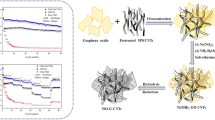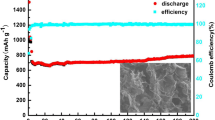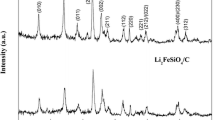Abstract
The electrospun Co3O4 nanotubes encapsulated by graphene membrane are successfully synthesized via a novel and efficient method. The Co3O4 nanotubes with the diameter of ~200 nm are prepared by electrospinning combined with sintering process. Graphene is wrapped on the charge-modified surface of Co3O4 nanotubes by the mutual electrostatic interactions. The as-prepared graphene/Co3O4 nanotubes are applied as anode materials for lithium-ion batteries and show the improved rate capacities (up to 430.9 mAh g−1 at the current density of 1600 mA g−1) and excellent rechargeable stability (961.4 mAh g−1 at the current density of 100 mA g−1 after 80 cycles). The existence of graphene membrane not only decreases the lithium ion transport path due to serving as the additional transport channel, but also provides the elastic buffer to avoid the agglomeration of the Co3O4 nanotubes. The nanotubes located in the graphene could effectively prevent the agglomeration of graphene membranes, and consequently keep their high active surface area. The complementary and synergistic effect of Co3O4 nanotubes and graphene makes a great contribution to the outstanding electrochemical properties.
Graphical Abstract
The graphene/Co3O4 nanotubes composites were applied as anode materials and shown excellent electrochemical performance.








Similar content being viewed by others
References
Goodenough JB (2014) Electrochemical energy storage in a sustainable modern society. Energy Environ Sci 7:14–18.
Liu J, Zhang JG, Yang ZG, Lemmon JP, Imhoff C, Graff GL,Li LY, Hu JZ, Wang CM, Xiao J, Xia G, Viswanathan VV, Baskaran S, Sprenkle V, Li XL, Shao YY, Schwenzer B (2013) Materials science and materials chemistry for large scale electrochemical energy storage: from transportation to electrical grid. Adv Funct Mater 23:929–946.
Etacheri V, Marom R, Elazari R, Salitra G, Aurbach D (2011) Challenges in the development of advanced Li-ion batteries: a review. Energy Environ Sci 4:3243–3262.
Goodenough JB, Park KS (2013) The Li-ion rechargeable battery: a perspective. J Am Chem Soc 135:1167–1176.
Chan CK, Zhang XF, Cui Y (2008) High capacity Li ion battery anodes using Ge nanowires. Nano Lett 8:307–309.
Buiel E, Dahn JR (1999) Li-insertion in hard carbon anode materials for Li-ion batteries. Electrochim Acta 45:121–130.
Jin YH, Wang L, Shang YM, Gao J, Li JJ, He XM (2015) Facile synthesis of monodisperse Co3O4 mesoporous microdisks as an anode material for lithium ion batteries. Electrochim Acta 151:109–117.
Guo WX, Sun WW, Wang Y (2015) Multilayer CuO@NiO hollow spheres: microwave-assisted metal-organic-framework derivation and highly reversible structure-matched stepwise lithium storage. ACS Nano 9:11462–11471.
Chen S, Xin YL, Zhou YY, Zhang F, Ma YR, Zhou HH, Qi LM (2015) Robust α-Fe2O3 nanorod arrays with optimized interstices as high-performance 3D anodes for high-rate lithium ion batteries. J Mater Chem A 3:13377–13383.
Hu T, Xin GQ, Sun HT, Sun X, Yu MP, Liu CS, Li J (2014) Electrospray deposition of a Co3O4 nanoparticles-graphene composite for a binder-free lithium ion battery electrode. RSC Adv 4:1521–1525.
Wu XY, Wang B, Li SM, Liu JH, Yu M (2015) Electrophoretic deposition of hierarchical Co3O4@graphene hybrid films as binder-free anodes for high-performance lithium-ion batteries. RSC Adv 5:33438–33444.
Li ZQ, Li B, Yin LW, Qi YX (2014) Prussion blue-supported annealing chemical reaction route synthesized double-shelled Fe2O3/Co3O4 hollow microcubes as anode materials for lithium-ion battery. ACS Appl Mater Interfaces 6:8098–8107.
Hao WJ, Chen SM, Cai YJ, Zhang L, Li ZX, Zhang SJ (2014) Three-dimensional hierarchical pompon-like Co3O4 porous spheres for high-performance lithium-ion batteries. J Mater Chem A 2:13801–13804.
Lu Y, Wang Y, Zou YQ, Jiao Z, Zhao B, He YQ, Wu MH (2010) Macroporous Co3O4 platelets with excellent rate capability as anodes for lithium ion batteries. Electrochem Commun 12:101–105.
An L, Yu L, Cao YJ, Li WY, Xu KB, Ji T, Zou RJ, Hu JQ (2016) Hierarchical architectures of Co3O4 ultrafine nanowires grown on Co3O4 nanowires with fascinating electrochemical performance. New J Chem 40:377–384.
Yan CS, Chen G, Zhou X, Sun JX, Lv VD (2016) Template-based engineering of carbon-doped Co3O4 hollow nanofibers as anode materials for lithium-ion batteries. Adv Funct Mater 26:1428–1436.
Zhou GM, Li L, Zhang Q, Li N, Li F (2013) Octahedral Co3O4 particles threaded by carbon nanotube arrays as integrated structure anodes for lithium ion batteries. Phys Chem Chem Phys 15:5582–5587.
Xu MW, Wang F, Zhang Y, Yang S, Zhao MS, Song XP (2013) Co3O4-carbon nanotube heterostructures with bead-on-string architecture for enhanced lithium storage performance. Nanoscale 5:8067–8072.
Wang HG, Yuan S, Ma DL, Zhang XB, Ya JM (2015) Electrospun materials for lithium and sodium rechargeable batteries: from structure evolution to electrochemical performance. Energy Environ Sci 8:1660–1681.
Du N, Zhang H, Chen BD, Wu JB, Ma XY, Liu ZH, Zhang YQ, Yang DR, Huang XH, Tu JP (2007) Porous Co3O4 nanotubes derived from Co4(CO)12 clusters on carbon nanotube templates: a highly efficient material for li-battery applications. Adv Mater 19:4505–4509.
Zhao F, Lu QF, Liu SW, Wang CQ (2014) In2O3/ZnO heterostructured nanotubes: electrospinning fabrication, characterization, and highly enhanced photocatalytic properties. J Sol-Gel Sci Technol 72:137–143.
Landau O, Rothschild A (2015) Fibrous TiO2 gas sensors produced by electrospinning. J Electroceram 35:148–159.
Novoselov KS, Geim AK, Morozov SV, Jiang D, Zhang Y, Dubonos SV, Grigorieva IV, Firsov AA (2004) Electric field effect in atomically thin carbon films. Science 306:666–669.
Niu ZQ, Zhang L, Liu LL, Zhu BW, Dong HB, Chen XD (2013) All-solid-state flexible ultrathin micro-supercapacitors based on graphene. Adv Mater 25:4035–4042.
Higgins TM, McAteer D, Mesquita Coelho JC, Sanchez BM, Gholamvand Z, Moriarty G, McEvoy N, Berner NC, Duesberg GS, Nicolosi V (2014) Effect of percolation on the capacitance of supercapacitor electrodes prepared from composites of manganese dioxide nanoplatelets and carbon nanotubes. ACS Nano 8:9567–9579.
Geim AK, Novoselov KS (2007) The rise of graphene. Nat Mater 6:183–191.
Wu CH, Shen Q, Mi R, Deng SX, Shu YQ, Wang H, Liu JB, Yan H (2014) Three-dimensional Co3O4/flocculent graphene hybrid on Ni foam for supercapacitor applications. J Mater Chem A 2:15987–15994.
Bao WX, Yu BZ, Li WL, Fan HM, Bai JT, Ren ZY (2015) Co3O4/nitrogen-doped grapheme/carbon nanotubes: an innovative ternary composite with enhanced electrochemical performance. J Alloy Compd 647:873–879.
Li L, Zhou GM, Shan XY, Pei SF, Li F, Cheng HM (2014) Co3O4 mesoporous nanostructures@graphene membrane as an integrated anode for long-life lithium-ion batteries. J Power Sources 255:52–58.
Xu JM, Wu JS, Luo LL, Chen XQ, Qin HB, Dravid V, Mi SB,Jia CL (2015) Co3O4 nanocubes homogeneously assembled on few-layer graphene for high energy density lithium-ion batteries. J Power Sources 274:816–822.
Lou YB, Liang J, Peng YL, Chen JX (2015) Ultra-small Co3O4 nanoparticles-reduced graphene oxide nanocomposite as superior anodes for lithium-ion batteries. Phys Chem Chem Phys 17:8885–8893.
Zhang ZH, Zhang LD, Li W, Yu AS, Wu PY (2015) Carbon-coated mesoporous TiO2 nanocrystals grown on graphene for lithium-ion batteries. ACS Appl Mater Interfaces 7:10395–10400.
Luo DC, Zhang GX, Liu JF, Sun XM (2011) Evaluation criteria for reduced graphene oxide. J Phys Chem C 115:11327–11335.
Marcano DC, Kosynkin DV, Berlin JM, Sinitskii A, Sun ZZ, Slesarev A, Alemany LB, Lu W, Tou JM (2010) Improved synthesis of graphene oxide. Acs Nano 4:4806–4814.
Zhou WW, Zhu JX, Cheng CW, Liu JP, Yang HP, Cong CX, Guan C, Jia XT, Fan HJ, Yan QY, Li CM, Yu T (2011) A general strategy toward graphene@metal oxide core–shellnanostructures for high-performance lithium storage. Energy Environ Sci 4:4954–4961.
Hou DF, Luo W, Huang YH, Yu JC, Hua XL (2013) Synthesis of porous Bi4Ti3O12 nanofibers by electrospinning and their enhanced visible-light-driven photocatalytic properties. Nanoscale 5:2028–2035.
Xiang HF, Long YH, Yu XL, Zhang XL, Zhao N, Xu J (2011) A novel and facile method to prepare porous hollow CuO and Cu nanofibers based on electrospinning. CrystEngComm 13:4856–4860.
Guo HL, Wang XF, Qian QY, Wang FB, Xia XH (2009) A green approach to the synthesis of graphene nanosheets. Acs Nano 3:2653–2659.
Ma LB, Zhou H, Shen XP, Chen QR, Zhu GX, Ji ZY (2014) Facile synthesis of Co3O4 porous nanosheets/reduced graphene oxide composites and their excellent supercapacitor performance. RSC Adv 4:53180–53187.
Cheng J, Wang B, Park CM, Huang H (2013) CNT@Fe3O4@C coaxial nanocables: one-pot, additive-free synthesis and remarkable lithium storage behavior. Chem-A Eur J 19:9866–9874.
Huang ZY, Zhou HH, Li CH, Zeng FY, Fu CP, Kuang YF (2012) Preparation of well-dispersed PdAu bimetallic nanoparticles on reduced graphene oxide sheets with excellent electrochemical activity for ethanol oxidation in alkaline media. J Mater Chem 22:1781–1785.
Zhu ZZ, Lu GZ, Zhang ZG, Guo Y, Guo YL, Wang YQ (2013) Highly active and stable Co3O4/ZSM-5 catalyst for propane oxidation: effect of the preparation method. ACS Catal 3:1154–1164.
Wu ZS, Ren W, Wen L, Gao L, Zhao J, Chen Z, Zhou G, Li F, Cheng HM (2010) Graphene Anchored with Co3O4 Nanoparticles as Anode of Lithium Ion Batteries with Enhanced Reversible Capacity and Cyclic Performance. ACS Nano 4:3187–3194.
Liang YY, Li YG, Wang HL, Zhou JG, Wang J, Regier T, Dai HJ (2011) Co3O4 nanocrystals on graphene as a synergistic catalyst for oxygen reduction reaction. Nat Mater 10:780–786.
Zhao J, Liu ZS, Qin YL, Hu WB (2014) Fabrication of Co3O4/graphene oxide composites using supercritical fluid and their catalytic application for the decomposition of ammonium perchlorate. CrystEngComm 16:2001–2008.
Peng CX, Chen BD, Qin Y, Yang SH, Li CZ, Zuo YH, Liu SY, Yang JH (2012) Facile ultrasonic synthesis of CoO quantum dot/graphene nanosheet composites with high lithium storage capacity. Acs Nano 6:1074–1081.
Li LL, Cheah YL, Ko YW, The PF, Wee G, Wong CL, Peng SJ, Srinivasan M (2013) The facile synthesis of hierarchical porous flower-like NiCo2O4 with superior lithium storage properties. J Mater Chem A 1:10935–10941.
Yang XL, Fan KC, Zhu YH, Shen JH, Jiang X, Zhao P, Li CZ (2012) Tailored graphene-encapsulated mesoporous Co3O4 composite microspheres for high-performance lithium ion batteries. J Mater Chem 22:17278–17283.
Li WY, Xu LN, Chen J (2005) Co3O4 Nanomaterials in Lithium-Ion Batteries and Gas Sensors. Adv Funct Mater 15:851–857.
Su QM, Zhang J, Wu YS, Du GH (2014) Revealing the electrochemical conversion mechanism of porous Co3O4 nanoplates in lithium ion battery by in situ transmission electron microscopy. Nano Energy 9:264–272.
Li BJ, Cao HQ, Shao J, Li GQ, Qu MZ, Yin G (2011) Co3O4@graphene composites as anode materials for high-performance lithium ion batteries. Inorg Chem 50:1628–1632.
Lu LQ, Wang Y (2011) Sheet-like and fusiform CuO nanostructures grown on graphene by rapid microwave heating for high Li-ion storage capacities. J Mater Chem 21:17916–17921.
Dedryvère R, Laruelle S, Grugeon S, Poizot P, Gonbeau D,Tarascon JM (2004) Contribution of X-ray Photoelectron Spectroscopy to the Study of the Electrochemical Reactivity of CoO toward Lithium. Chem Mater 16:1056–1061.
Rai AK, Gim J, Anh LT, Kim J (2013) Partially reduced Co3O4/graphene nanocomposite as an anode material for secondary lithium ion battery. Electrochim Acta 100:63–71.
Choi BG, Chang SJ, Lee YB, Bae JS, Kim HJ, Huh YS (2012) 3D heterostructured architectures of Co3O4 nanoparticles deposited on porous graphene surfaces for high performance of lithium ion batteries. Nanoscale 4:5924–5930.
Liao QY, Li N, Jin SX, Yang GW, Wang CX (2015) All-solid-state symmetric supercapacitor based on Co3O4 nanoparticles on vertically aligned graphene. Acs Nano 9:5310–5317.
Zhou GM, Wang DW, Li L, Li N, Li F, Cheng HM (2013) Nanosize SnO2 confined in the porous shells of carbon cages for kinetically efficient and long-term lithium storage. Nanoscale 5:1576–1582.
Acknowledgements
This work was supported by Project of Independent Innovation of University Institute of Jinan (Grant No. 201311034), Science and Technology Development Plan Project of Shandong Province (2014GGX102039) and Project of Shandong Province Higher Educational Science and Technology Program (Grant no. J14LA01).
Author information
Authors and Affiliations
Corresponding author
Ethics declarations
Conflict of interest
The authors declare that they have no competing interests.
Electronic supplementary material
Rights and permissions
About this article
Cite this article
Li, D., Lu, Q., Guo, E. et al. Graphene membrane encapsulated Co3O4 nanotubes with superior capacity and stability as anode materials for lithium ion batteries. J Sol-Gel Sci Technol 82, 75–84 (2017). https://doi.org/10.1007/s10971-016-4274-y
Received:
Accepted:
Published:
Issue Date:
DOI: https://doi.org/10.1007/s10971-016-4274-y




